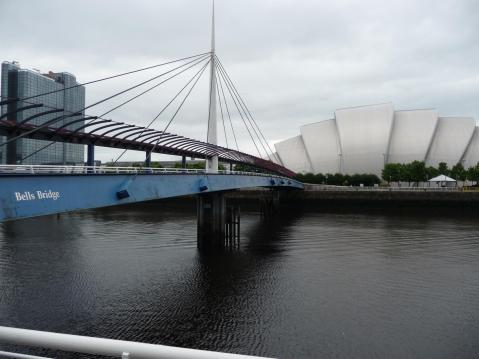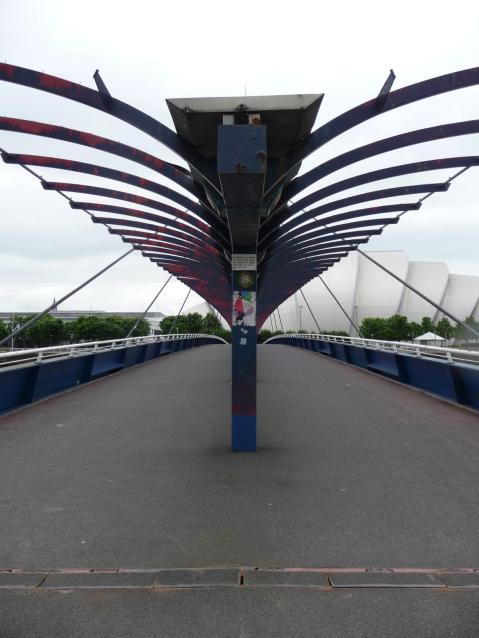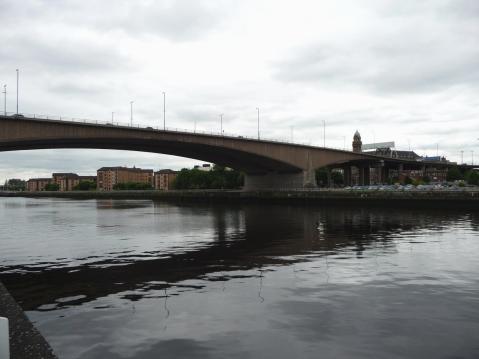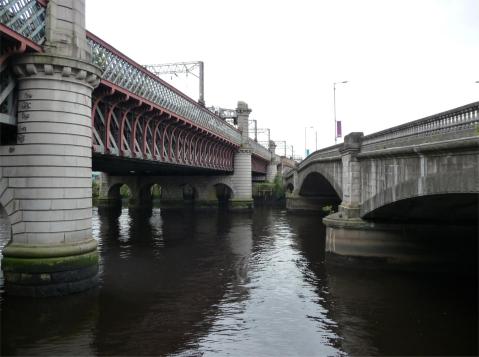Glasgow Bridges (Part 1 of 2)
The River Clyde has been a dominant part in the life of Glasgow and it’s bridges have played an ever more important role in the fortunes of the city. From the earliest recorded bridge in 1285 to the most recent in 2009 these crossings have been pivotal in both social and economic capacities.
Travelling from West to East the 1st bridge we see is the Millennium Bridge.
Built in 2002 as part of the Glasgow Science Centre project to improve links between both sides of the river.
The centre 2 elements of the bridge can be raised to allow the passage of larger vessels. This apparently only requires the same amount of energy as is needed to power a 100 watt lamp. In the background is the Glasgow Science Centre and the Glasgow Tower. The Tower is capable of rotating 360 degrees with the wind but has been beset by many serious problems since it opened. It is currently closed (June 13th 2012).
Next is the Bell’s Bridge. Construction of the bridge, sponsored by Bell’s & Son whisky company, was completed in 1988 with the aim of connecting the site of the International Garden Festival and the S.E.C.C.
The bridge is in 2 sections. The North side is fixed and the South side, the part with the pointed column and support cables rotates 90 degrees to create 2 lanes allowing for large vessels to pass.
One of the most recent bridges on the Clyde is the Clyde Arc. This is fondly known locally as the “Squinty Bridge” due to the fact that it is curved and is built at an angle across the river, which is caused by the location of suitable landing points on the banks.
Probably the most dominant bridge in Glasgow is the Kingston Bridge. It’s also probably the most important given that it carries approximately 150,000 vehicles every day along the M8 motorway through the centre of Glasgow. It is the largest urban bridge in the UK. It was completed in 1970 after 3 years of construction. Due to the heavy use it was strengthened in recent years. The whole bridge was jacked up and moved a distance of 50mm (2 inches). It doesn’t sound much but you must consider that the bridge weighs 52,000 tonnes!!!
The mural on the North support of the bridge, commissioned as part of the Clean Glasgow Campaign, was painted by Australian artist Sam Bates to commemorate the 2014 Glasgow Commonwealth Games. It has been specially treated and is hoped to last for up to 100 years.
The newest bridge in the city is the Tradeston Footbridge in the area of the International Financial Services District. Another bridge with a fun nickname (the Squiggly Bridge) due to it’s curves, it was opened in 2009. The triangular steel ‘fins’ are actually the main support structure which enables the bridge deck to be thinner.
Originally planned for construction in 1914, the George the Fifth Bridge (George V Bridge) was delayed by the onset of World War 1 and was eventually completed in 1928.
Right next to the George V Bridge is the main railway crossing into Glasgow Central Station. This is the 2nd Caledonian Railway Bridge. Due to competition from rival rail companies and the need for development the Caledonian Railway Company built their second bridge across the Clyde in 1905 and was built next to the original bridge.
The Caledonian Railway line originally stopped just south of the river. Then, to compete with the Clyde Union Railway Company who had already crossed the river upstream they built the 1st Caledonian Railway Bridge. The bridge was completed in 1878 and carried 4 tracks across the river. Sadly, the granite piers are all that is left of the original bridge, the rest having been dismantled in the late 1960’s.

The remaining granite piers of the 1st Caledonian Railway Bridge next to the current 2nd Caledonian Railway Bridge
On the granite piers there is an inscription carved by the poet Ian Hamilton Finlay and his collaborators, in Greek and English, a translated quote from Plato’s The Republic which, in English, reads “All greatness stands firm in the storm”.

















